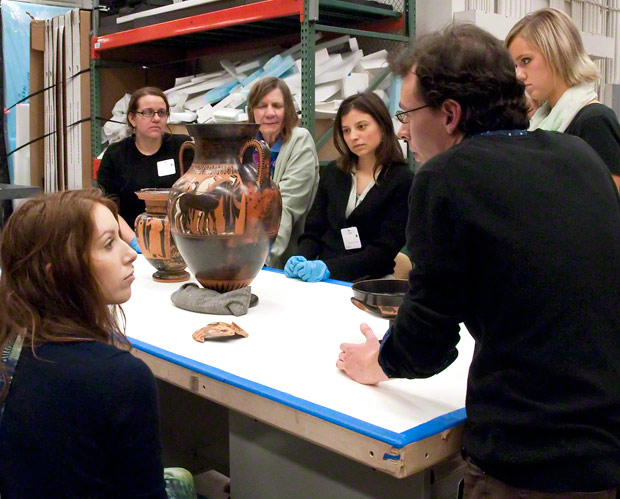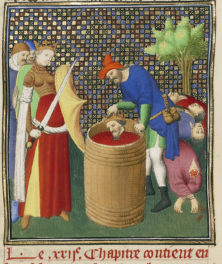Eleven teachers enter an underground room at the Getty Villa. In a space with wooden crates marked “fragile” sits a large table. They are asked to put on latex gloves as an aura of anticipation fills the air.
“When was this made?” asks curator David Saunders as he pulls an object from one of the smaller boxes sitting on the table.
The group correctly guesses about 600 B.C.
The gathering is part of Wednesday Teacher Workshops at the Getty Villa, a series of free, two-hour workshops in which Getty staff meet with local teachers to share their passion for the arts and develop lesson plans for students who will visit the Museum. It’s just one of the offerings in the Education Department’s free professional development programs for K-12 teachers.

David Saunders speaks with a group of students from UCLA who visited the storeroom on a previous occasion. Most storeroom visits are reserved for college groups.
“Teachers can learn about a topic so that when they come back with their students they feel comfortable and confident passing information along,” said Jeanette LaVere, education specialist at the Getty Villa. “A lot of times teachers are overwhelmed with day-to-day teaching. They want to make sure the experience of a museum visit resonates with their students. The workshops help connect with what they’re already studying.”
The topic of this workshop was myth and narrative in Greek Art. The participants, teachers with students ranging from kindergartners to high school seniors, were invited to the Collections Store Room—home to the antiquities that aren’t on view in the galleries—to handle and inspect fragments and, in some cases, whole Greek vases and plates.
They were carefully handled and passed like…well, ancient Greek vases and plates.
It’s one thing to talk about art; it’s another thing to touch it. Teachers who attend the workshops can go back to their classrooms and share their accounts of their experience with students. Instead of consulting a textbook, students can consult their teachers.
“It’s no different from Superman or Sponge Bob on a sippy cup,” said Marcia Moore, an art history teacher at New Roads school in Santa Monica, as she inspected a sherd before passing it on to another teacher. “I want my students to understand that the Greeks were like us. We have our cups, decorated with pictures of our heroes, and our cultural stories.”
“Artists were drawing from a common stock of heroes and myths,” Saunders told the teachers about the paintings on the vases. “The themes and episodes can give us a glimpse of what their culture valued.”
Saunders also believes we shouldn’t overlook the vases’ original purpose. “These were objects that were meant to be handled, and drank from and used. They invite the viewer’s participation.”
The figures and scenes on their surface have to be decoded, and sometimes one has only a fragment or two to work with. Given a few clues, the teachers were able to pass fragments and piece together information very quickly: Black figures on the vase? It’s from Athens.
Saunders enjoys these workshops as much as the teachers.
“It’s important to me to understand what’s meaningful to visitors. Hearing from them keeps my focus and interest in ancient art fresh and relevant. That’s how I got into the subject—by being able to handle the pieces myself. You learn to engage with these pieces differently.”




The program of “teaching the teachers” seems very worthwhile. As someone who recently acquired several ancient Greek vases, I can attest to the value of being able to pick one up in your hands. History comes alive as you try to visualize who might have painted it and who might have used it. The red and black-figure scenes are a glimpse of how people lived in a fascinating era.
I have had the pleasure of corresponding with Dr. Saunders and find him to be personable and knowledgeable; clearly an asset of the Getty.